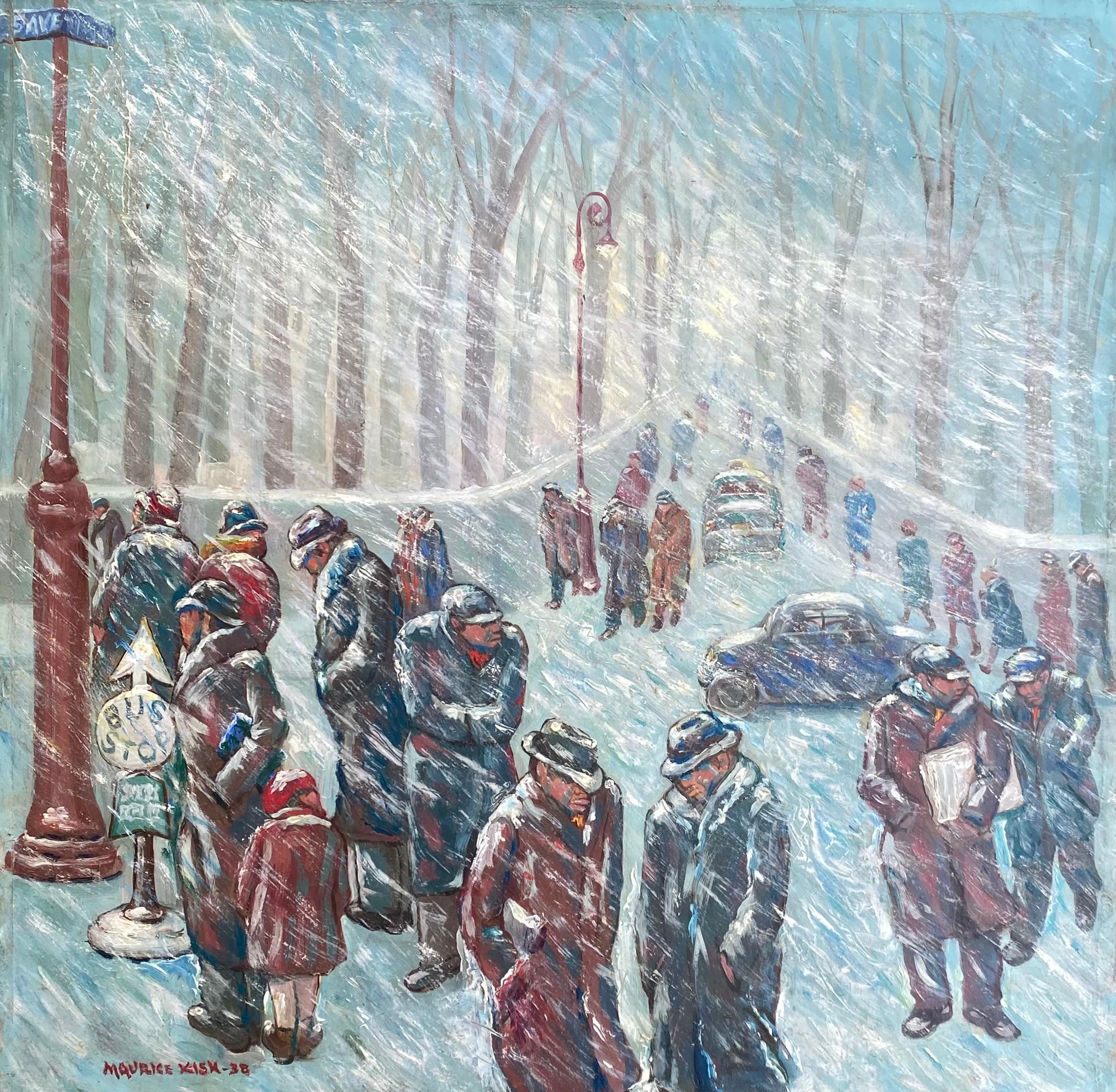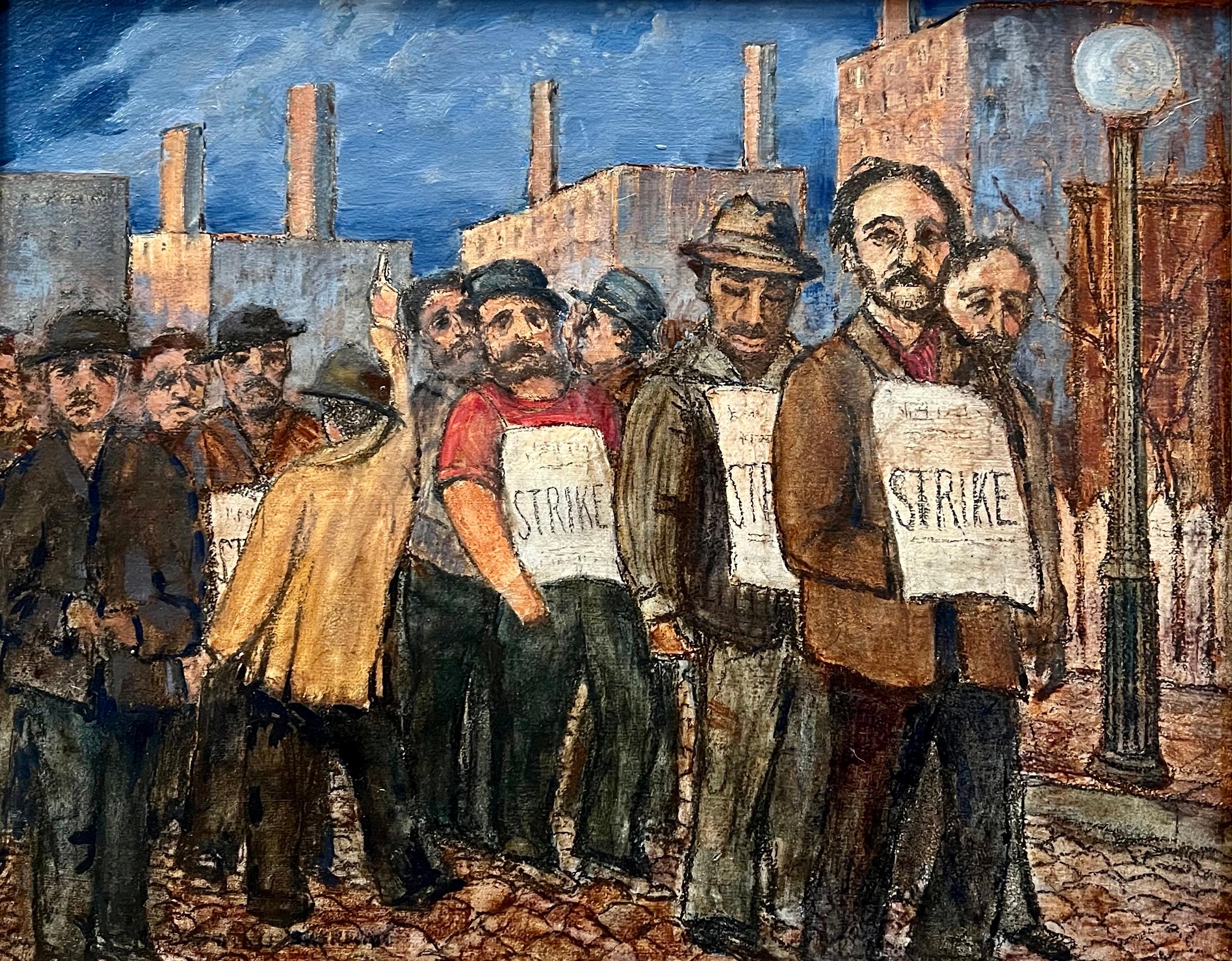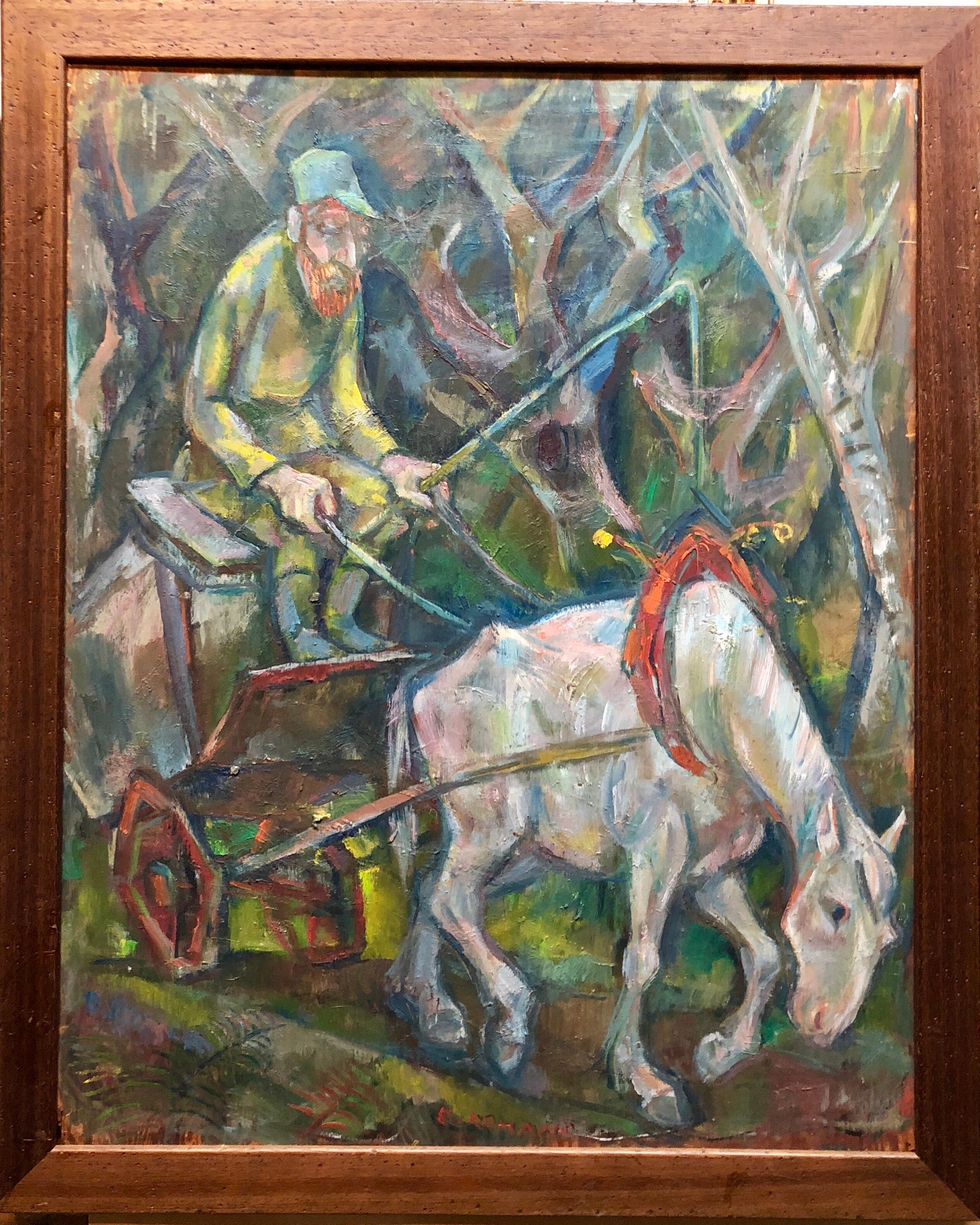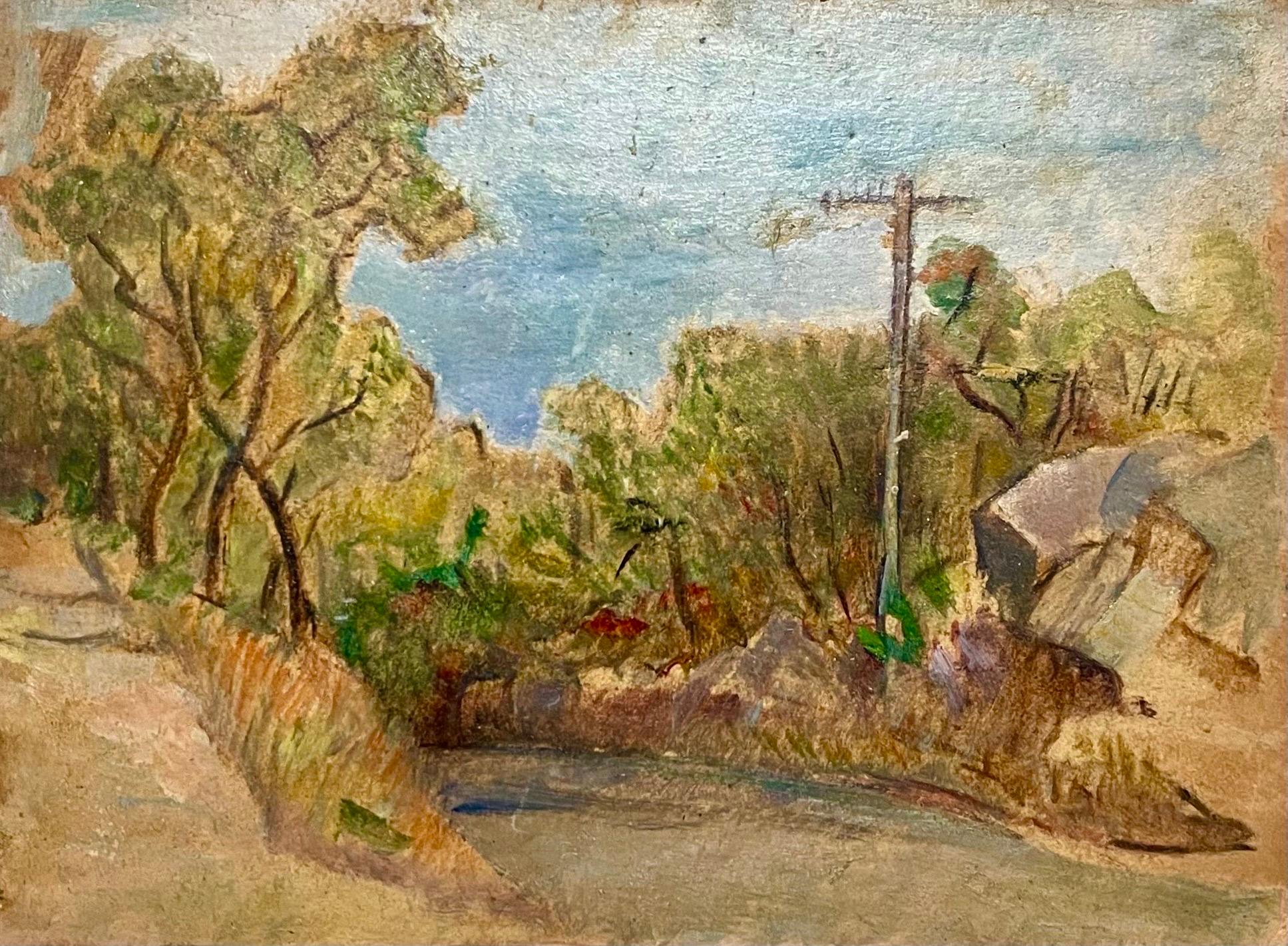Items Similar to Original Antique American Landscape Fishing Delaware River Oil Painting Framed
Want more images or videos?
Request additional images or videos from the seller
1 of 4
Jan NosekOriginal Antique American Landscape Fishing Delaware River Oil Painting Framed1910
1910
About the Item
A lovely scene adeptly painted by listed American artist and illustrator Jan Nosek (1876 - 1966) who was active in the late 19th and early 20th Century. This scene created in the early part of the 20th Century, "Fishing on the Delaware", utilizes fabulous brush strokes and colors to depict a charming sunset genre scene.
- Creator:Jan Nosek (American)
- Creation Year:1910
- Dimensions:Height: 8 in (20.32 cm)Width: 14 in (35.56 cm)
- Medium:
- Movement & Style:
- Period:
- Condition:
- Gallery Location:Buffalo, NY
- Reference Number:1stDibs: LU13928360502
About the Seller
4.9
Platinum Seller
These expertly vetted sellers are 1stDibs' most experienced sellers and are rated highest by our customers.
Established in 1970
1stDibs seller since 2015
2,381 sales on 1stDibs
Typical response time: 1 hour
- ShippingRetrieving quote...Ships From: Buffalo, NY
- Return PolicyA return for this item may be initiated within 10 days of delivery.
More From This SellerView All
- A Pair of Modern Impressionist Landscape Oil Paintings Framed Female artist NYLocated in Buffalo, NYA Pair of Modernist Landscapes by listed female artist Margaret Munro Stratton McLennan. Margaret was a painter working in the early 20th Century in the Syracuse area. These charmi...Category
1920s American Modern Landscape Paintings
MaterialsBoard, Oil
- Impressionist Antique American Oil Painting Philadelphia Female Artist 1918By Clara Elizabeth SackettLocated in Buffalo, NYA stunning impressionist oil painting by listed female artist Clara Elizabeth Sackett.Category
1910s Impressionist Landscape Paintings
MaterialsBoard, Oil
- Antique American Folk Art Dog Man Woods Oil Painting Original Frame Gold 19th C.Located in Buffalo, NYAn antique American folk art painting in its original period frame. Featuring a man walking his dogs in the woods with a stunning s...Category
1890s Folk Art Landscape Paintings
MaterialsOil, Board
- Albright Knox Gallery Label Signed Landscape Oil Painting Lake River NocturnalLocated in Buffalo, NYA charming painting of a quaint lake at night with the moon reflecting on calm waters. Bearing an Albright Knox Art Gallery "Art Week" label from 1941 t...Category
1940s Impressionist Landscape Paintings
MaterialsOil, Board
- Industrial SeasapeLocated in Buffalo, NYA stunning American modern industrial painting by an unknown artist with a very skilled hand. This beautiful impressionist painting depict...Category
20th Century Impressionist Figurative Paintings
MaterialsBoard, Oil
- Antique Oil Painting of Soldiers and Woman on the StreetLocated in Buffalo, NYAntique oil painting of soldiers and woman on the street. Oil on board. Framed.Category
Late 19th Century Realist Figurative Paintings
MaterialsBoard, Oil
You May Also Like
- "Industrial Cityscape, Chicago" WPA Modernism Mid-Century Cityscape 20th CenturyBy Aaron BohrodLocated in New York, NYMidwestern Chicago artist Aaron Bohrod painted in 1931 this modernist industrial cityscape during the WPA of the 20th Century. Aaron Bohrod (American 1907 – 1992), Industrial Citysc...Category
1930s American Modern Landscape Paintings
MaterialsOil, Board
- Waiting for the Bus in a Blizzard- WPA American Scene 1938 NYC Modernism RealismBy Maurice KishLocated in New York, NYWaiting for the Bus in a Blizzard- WPA American Scene 1938 NYC Modernism Realism. 16 x 16 inches, Oil on board, Signed and dated 1938 lower left. ...Category
1930s American Modern Figurative Paintings
MaterialsOil, Board
- WPA Scene American Modernism 20th Century Workers Strike Realism IndustrialLocated in New York, NYWPA Scene American Modernism 20th Century Workers Strike Realism Industrial "Pawns" 16 x 20 inches,. Oil on board, c. 1930’s. Signed lower left. Stowell Sherman...Category
1930s American Modern Figurative Paintings
MaterialsOil, Board
- Large Modernist Oil Painting 1940s, Judaica Hasidic Shtetl Wagon Driver WPA EraBy Emanuel Glicenstein RomanoLocated in Surfside, FLGenre: Modern Subject: Landscape with figure of horse, driver and wagon Medium: Oil Surface: wood Board EMANUEL ROMANO Rome, Italy, b. 1897, d. 1984 Emanuel Glicen Romano was born in Rome, September 23, 1897. His father Henryk Glicenstein was a sculptor and was living in Rome with his wife Helena (born Hirszenberg) when Emanuel was born. His father obtained Italian citizenship and adopted the name Enrico. Emanuel was brought up in Italy, Switzerland, Germany, England and Poland. In 1926 Emanuel Glicenstein Romano and his father sailed for New York. They briefly visited Chicago. Romano's sister, Beatrice, and mother only joined them in New York years later. Romano changed his name on his arrival to America and some have erroneously speculated that this was to avoid antisemitic discrimination. In truth, as the son of a highly-regarded artist, Romano changed his name to ensure that any success or recognition he would later attain, would be the result of nothing other than his own merit as an artist, and not on account of his father's fame. In 1936 Romano was worked for the WPA Federal Art Project creating murals. ( there were many jewish artists active with in the WPA period. notably Chaim Gross, Ben Shahn, Isaac and Moses Soyer, Abraham Rattner and many others. During and immediately after World War II, Romano created a series of allegorical works depicting graphic holocaust images that were held closely by the family until after his passing. One of these works is now on permanent display in the Florida Holocaust Museum in St. Petersburg Florida. Emanuel's father died in 1942 in a car accident before they could realize their shared dream of visiting Israel. In 1944 Romano, having completed his degree at the Pennsylvania Academy of Fine Arts and the Art Institute of Chicago, began teaching at the City College of New York. Romano moved to Safed, Israel in 1953 and established an art museum in his father's memory, the Glicenstein Museum. COLLECTIONS Indianapolis Museum of Art Metropolitan Museum of Art Boston Fine Arts Museum Fogg Museum Musée Nacional de France Recently his work has been added to the Florida Holocaust Museum collection. His notable works include his holocaust themed allegorical paintings as well as portraits of Marianne Moore, his father and William Carlos Williams...Category
1930s American Modern Figurative Paintings
MaterialsOil, Board
- Simka Simkhovitch WPA Artist Oil Painting Gouache American Modernist PowerlineBy Simka SimkhovitchLocated in Surfside, FLSimka Simkhovitch (Russian/American 1893 - 1949) This came with a small grouping from the artist's family, some were hand signed some were not. These were studies for larger paintings. Simka Simkhovitch (Симха Файбусович Симхович) (aka Simka Faibusovich Simkhovich) (Novozybkov, Russia May 21, 1885 O.S./June 2, 1885 N.S.—Greenwich, Connecticut February 25, 1949) was a Ukrainian-Russian Jewish artist and immigrant to the United States. He painted theater scenery in his early career and then had several showings in galleries in New York City. Winning Works Progress Administration (WPA) commissions in the 1930s, he completed murals for the post offices in Jackson, Mississippi and Beaufort, North Carolina. His works are in the permanent collections of the Dallas Museum of Art, the National Museum of American Art and the Whitney Museum of American Art. Born outside Kyiv (Petrograd Ukraine) into a Jewish family who owned a small department store. During a severe case of measles when he was seven, Simcha Simchovitch sketched the views outside his window and decided to become an artist, over his father's objections. Beginning in 1905, he studied at the Grekov Odessa Art School and upon completion of his studies in 1911 received a recommendation to be admitted to the Imperial Academy of Arts. Though he enrolled to begin classes in architecture, painting, and sculpture at the Imperial Academy, he was dropped from the school roster in December because of the quota on the number of Jewish students and drafted into the army. Simchovitch served as a private in the 175th Infantry Regiment Baturyn [ru] until his demobilization in 1912. Re-enrolling in the Imperial Academy, he audited classes. Simka Simkhovitch exhibited paintings and sculptures in 1918 as part of an exhibition of Jewish artists and in 1919 placed 1st in the competition "The Great Russian Revolution" with a painting called "Russian Revolution" which was hung in the State Museum of Revolution. In 1922, Simkha Simkhovitch exhibited at the International Book Fair in Florence (Italian: Fiera Internazionale del Libro di Firenze). In 1924, Simkhovitch came to the United States to make illustrations for Soviet textbooks and decided to immigrate instead. Initially he supported himself by doing commercial art and a few portrait commissions. In 1927, he was hired to paint a screen for a scene in the play "The Command to Love" by Fritz Gottwald and Rudolph Lothar which was playing at the Longacre Theatre on Broadway. Art dealers began clamoring for the screen and Simkhovitch began a career as a screen painter for the theater. Catching the attention of the screenwriter, Ernest Pascal, he worked as an illustrator for Pascal, who then introduced him to gallery owner, Marie Sterner. Simkhovitch's works appeared at the Marie Sterner Gallery beginning with a 1927 exhibit and were repeated the following year. Simkhovitch had an exhibit in 1929 at Sterner's on circus paintings. In 1931, he held a showing of works at the Helen Hackett Gallery, in New York City and later that same year he was one of the featured artists of a special exhibit in San Francisco at the California Palace of the Legion of Honor in Lincoln Park. The exhibit was coordinated by Marie Sterner and included four watercolors, including one titled "Nudes". He is of the generation of Russian Soviet artists such as Isaac Pailes, Serge Charchoune, Marc Chagall, Chana Orloff, Isaac Ilyich Levitan, and Ossip Zadkine. In 1936, Simkhovitch was selected to complete the mural for the WPA Post office project in Jackson, Mississippi. The mural was hung in the post office and courthouse in 1938 depicted a plantation theme. Painted on the wall behind the judge’s bench, “Pursuits of Life in Mississippi”, a depiction of black workers engaged in manual labor amid scenes of white professionals and socialites, was eventually covered over in later years during renovations due to its stereotypical African American imagery. Simka painted what he thought was typical of Jackson. His impression of pre-civil rights Mississippi was evidently Greek Revival column houses, weeping willow trees, working class families, and the oppression of African Americans. He painted African American men picking cotton, while a white man took account of the harvest and a white judge advised a white family, calling it Pursuits of Life in Mississippi. Though clearly endorsed by the government and initially generally well-received, the mural soon raised concerns with locals as the climate toward racial segregation began to change. The main concern was whether depictions that show African Americans in subjugated societal roles should be featured in a courtroom. The following year, his painting "Holiday" won praise at an exhibition in Lincoln, Nebraska. In 1940, Simkhovitch's second WPA post office project was completed when four murals, "The Cape Lookout Lighthouse and the Orville W. Mail Boat", "The Wreck of the Crissie Wright", "Sand Ponies" and "Canada Geese" were installed in Beaufort, North Carolina. The works were commissioned in 1938 and did not generate the controversy that the Jackson mural had. The main mural is "The Wreck of the Crissie Wright" and depicts a shipwreck which had occurred in Beaufort in 1866. "The Cape Lookout Lighthouse and the Orville W. Mail Boat" depicted the lighthouse built in 1859 and the mail boat that was running mail during the time which Simkhovitch was there. The boat ran mail for the area until 1957. "Sand Ponies" shows the wild horses common to the North Carolina barrier islands and "Canada Geese" showed the importance of hunting and fishing in the area. All four murals were restored in the 1990s by Elisabeth Speight, daughter of two other WPA muralists, Francis Speight...Category
1930s American Modern Landscape Paintings
MaterialsGouache, Oil, Board
- Simka Simkhovitch WPA Artist Oil Painting American Modernist Landscape Pond TreeBy Simka SimkhovitchLocated in Surfside, FLSimka Simkhovitch (Russian/American 1893 - 1949) This came with a small grouping from the artist's family, some were hand signed some were not. Thes...Category
1930s American Modern Landscape Paintings
MaterialsOil, Board
Recently Viewed
View AllMore Ways To Browse
Antique Painting Early American
Original Antique Oil Painting On Board
Jans Antiques
Antique Genre Painting
Delaware River
Antique Painting Sunset
Antique Oil Painting Sunset
Antique Sunset Landscape
Antique Oil Sunset Landscape
Antique Fishing Paintings
Antique Delaware
The Dutch Villa
Antique Street Scenes Oil Paintings
Scottish Highland
San Francisco Seascape
West Bend
Grey Gray Pearls
President Grant




